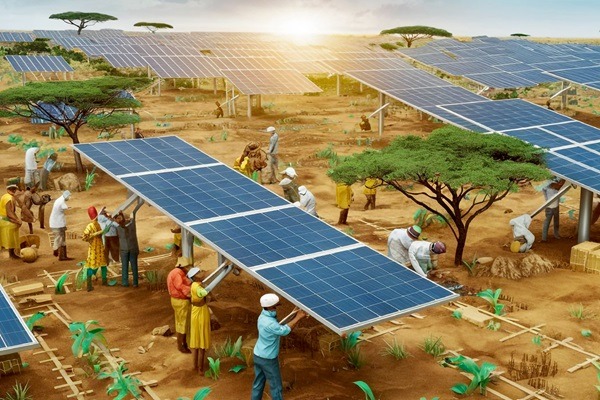Unlocking Africa’s Agricultural Potential
A Path to Sustainable Development and Global Food
The agricultural sector in Africa has been the lifeline of its burgeoning population, catering to a staggering chunk of about 70% of its workforce. Suffice it to say that this niche also accounts for about 40% of the continent’s gross domestic product. Despite this huge economic potential, a significant percentage of the vulnerable population in Africa still lives in rural areas thereby dampening its ability to propel its export potential within international trade.
There has been no gainsaying about the immense potential laying fallow within the continent. With a reservoir of arable land, untapped water resources and abundance of labour, the continent has what it takes to penetrate the global agricultural market while exploiting its comparative advantage over other regions.
The Genesis
Given the size of Africa’s workforce operating within the sector in context, it is quite worrisome to realize how the continent’s share of the global agricultural market has shrunk in the last few decades. Africa’s nemesis began when the Green Revolution transformed tropical agricultural practices in Asia and Latin America in the 1960s while the continent languished in a blind spot, causing her to grapple under structural reforms in the 1990s. Suffice it to say that these reforms assuaged the rate of decline in the continent’s global agricultural market share. However, the total productivity growth in agriculture remained at such a low ebb with the likes of Thailand and Indonesia churning out more exports than the whole of Sub-Saharan Africa. It is worth noting that while regions like South Asia exploited the cultivation of high-yielding varieties to lift millions of its population above the poverty line, Africa largely relied on increasing the expanse of arable land under cultivation. As promising as Africa’s approach might look, the inability to maximize irrigation development meant it had to grapple with yields that are not commensurate with the percentage area of expansion.
Amidst these teething challenges, the agricultural sector has also witnessed low private sector investment exacerbated by unfavourable policy environment. Prior to the structural reforms of the early 1990s, reliance on State-controlled marketing boards to purchase agricultural products was at the detriment of the private sector. Consequently, the profitability of investments in the agricultural sector had to contend with these myriads of challenges until the trend began to shift in the mid-2000s.
The Revolution
The early 21st century marked a significant turning point for Africa’s agricultural sector, driven by a confluence of economic, demographic, and global trends. As global markets expanded and new opportunities emerged, Africa found itself at the center of an agricultural renaissance, fueled by rising demand, increased investment, and a growing recognition of the sector’s untapped potential.
One of the most significant developments contributing to this revolution has been the growth of urban food markets across the continent. Africa’s urban population is projected to grow to 1.5 billion by 2050, with urban food consumption expected to quadruple during this period. This demographic shift has transformed cities into dynamic hubs of food demand, creating opportunities for both small-scale producers and large agribusinesses. Countries like Nigeria, Kenya, and South Africa have witnessed a rapid expansion of urban food markets, driven by a rising middle class with evolving dietary preferences. This has stimulated demand for a more diverse array of agricultural products, including processed foods, dairy, and high-value crops, fostering a more vibrant and competitive agricultural sector.
Parallel to this domestic shift, development partners have intensified their focus on Africa’s agricultural sector. Unlike the early 2000s, when agricultural support was relatively limited, international organizations and development finance institutions now recognize agriculture as a critical driver of economic growth and poverty reduction. Initiatives like the Comprehensive Africa Agriculture Development Programme (CAADP) have attracted substantial funding, with commitments exceeding $30 billion from global partners. The World Bank and African Development Bank have ramped up their agricultural investments, targeting infrastructure development, research, and capacity building. These efforts have significantly bolstered productivity and market access, laying the groundwork for sustained growth.
Equally transformative has been the surge in private sector interest. Recognizing the sector’s profitability and long-term potential, both local and international investors are increasingly committing resources to African agriculture. Agribusinesses are expanding their footprints, investing in supply chains, processing facilities, and export-oriented production. Companies such as Dangote Group in Nigeria and Olam International have spearheaded large-scale projects, while smaller enterprises are innovating in areas like agritech and value-added processing. This influx of private capital has not only increased productivity but also introduced modern practices and technologies that are reshaping the agricultural landscape.
Together, these factors—booming urban food markets, heightened development partner engagement, and rising private sector involvement—have catalyzed a revolutionary shift in African agriculture. The sector is no longer seen as merely subsistence-based; it is emerging as a cornerstone of economic development, job creation, and food security, positioning Africa to become a key player in the global agricultural arena.
The Potentials: Opportunities for Investors
Africa’s agricultural sector stands at the cusp of a transformative era, teeming with opportunities that promise substantial returns for discerning investors. The continent’s inherent strengths—vast arable land, abundant water resources, and a youthful workforce—position it as a potential global agricultural powerhouse. To unlock these potentials, strategic investments in key areas are paramount.
1. Harnessing Untapped Arable Land
With nearly 60% of the world’s uncultivated arable land, Africa presents an unparalleled opportunity for large-scale agricultural ventures. Countries such as Sudan, the Democratic Republic of Congo, and Mozambique boast fertile plains waiting to be cultivated. Strategic investment in commercial farming can unlock these lands’ productivity, enhancing food security and positioning Africa as a leading food exporter. Integrating modern farming techniques and sustainable practices will be critical in maximizing yield and ensuring long-term viability.
2. Leveraging Water Resources for Irrigation
Africa’s reliance on rain-fed agriculture has long stifled its productivity. However, the continent holds vast renewable water resources in major river basins like the Nile, Congo, and Niger. Investment in irrigation infrastructure can mitigate the impacts of erratic rainfall and unlock year-round agricultural production. Countries such as Egypt and South Africa have demonstrated the transformative power of irrigation; replicating these models across the continent can revolutionize agriculture, ensuring consistent and increased output.
3. Capitalizing on Rising Food Demand
With Africa’s population projected to reach 2.5 billion by 2050, urbanization and a burgeoning middle class are driving demand for diverse food products. There is a growing market for processed foods, dairy products, and high-value crops. Investors can leverage the opportunity to support food processing industries that add value to raw agricultural products, reducing post-harvest losses and increasing profitability. Establishing processing plants and cold storage facilities near production hubs can create a robust value chain, catering to both domestic and international markets.
4. Biofuel: A Sustainable Frontier
The global shift towards renewable energy has placed biofuels at the forefront of sustainable development. Africa’s sugarcane, palm oil, and jatropha sectors are poised to benefit from this trend. Countries like Nigeria and Ghana are emerging as significant players in biodiesel production, while South Africa leads in ethanol output. Investing in biofuel infrastructure not only taps into a lucrative market but also contributes to global carbon reduction goals. The demand for biofuel feedstocks, driven by EU mandates for renewable energy, presents a stable and growing market for African producers.
5. Agritech and Innovation
Technological innovation is reshaping global agriculture, and Africa is no exception. The rise of agritech startups focused on precision farming, mobile-based market platforms, and AI-driven climate analytics offers fertile ground for investment. These technologies address critical challenges such as low productivity, market access, and climate resilience. Supporting agritech initiatives can drive efficiency, reduce costs, and create scalable solutions for smallholder farmers, enhancing overall sector performance.
6. Infrastructure and Logistics
A persistent challenge in African agriculture is the lack of adequate infrastructure. Investments in transport networks, cold storage, and logistics hubs are essential to reducing post-harvest losses and ensuring that agricultural products reach markets efficiently. Public-private partnerships (PPPs) in infrastructure development can create a robust backbone for the sector, facilitating the seamless movement of goods and enhancing competitiveness in global markets.
7. Favourable Policy Landscape
African governments are increasingly recognizing the strategic importance of agriculture and are implementing investor-friendly policies. Initiatives such as Nigeria’s Agricultural Transformation Agenda and Ethiopia’s Growth and Transformation Plan offer incentives such as tax breaks, land access, and infrastructure support. Aligning investments with these national priorities can mitigate risks and enhance returns.
8. Regional and Global Market Integration
The advent of the African Continental Free Trade Area (AfCFTA) marks a turning point for agricultural trade. By reducing tariffs and fostering a larger integrated market, AfCFTA presents an opportunity to scale operations and access diverse markets across the continent. Investors can leverage this framework to build cross-border supply chains, enhancing competitiveness and tapping into new consumer bases.
Conclusion
Africa’s agricultural sector stands as a beacon of untapped potential, poised to drive economic transformation and global food security. The combination of abundant natural resources, rising local demand, and a favourable investment climate presents a compelling case for strategic investment. However, unlocking this potential requires a holistic approach—leveraging technology, building infrastructure, and fostering sustainable practices.
Investors have the opportunity not only to reap significant financial rewards but also to contribute to a transformative journey that can uplift millions, reduce poverty, and ensure food security. The future of African agriculture lies in its ability to embrace innovation, attract investment, and build resilient value chains. By unlocking these potentials, Africa can secure its place as a global agricultural powerhouse, turning its vast resources into prosperity and progress for the entire continent.




















Thank you for your sharing. I am worried that I lack creative ideas. It is your article that makes me full of hope. Thank you. But, I have a question, can you help me?
Your article helped me a lot, is there any more related content? Thanks!
Thank you for your sharing. I am worried that I lack creative ideas. It is your article that makes me full of hope. Thank you. But, I have a question, can you help me?
I don’t think the title of your article matches the content lol. Just kidding, mainly because I had some doubts after reading the article.
Thank you for your sharing. I am worried that I lack creative ideas. It is your article that makes me full of hope. Thank you. But, I have a question, can you help me?
Your article helped me a lot, is there any more related content? Thanks!
I don’t think the title of your article matches the content lol. Just kidding, mainly because I had some doubts after reading the article.
I don’t think the title of your article matches the content lol. Just kidding, mainly because I had some doubts after reading the article.
Your article helped me a lot, is there any more related content? Thanks!
Thank you for your sharing. I am worried that I lack creative ideas. It is your article that makes me full of hope. Thank you. But, I have a question, can you help me?
Thank you for your sharing. I am worried that I lack creative ideas. It is your article that makes me full of hope. Thank you. But, I have a question, can you help me?
Can you be more specific about the content of your article? After reading it, I still have some doubts. Hope you can help me.
Thanks for sharing. I read many of your blog posts, cool, your blog is very good.
I don’t think the title of your article matches the content lol. Just kidding, mainly because I had some doubts after reading the article.
Thank you for your sharing. I am worried that I lack creative ideas. It is your article that makes me full of hope. Thank you. But, I have a question, can you help me?
Thanks for sharing. I read many of your blog posts, cool, your blog is very good. https://accounts.binance.info/register?ref=P9L9FQKY
Thanks for sharing. I read many of your blog posts, cool, your blog is very good.
Thank you for your sharing. I am worried that I lack creative ideas. It is your article that makes me full of hope. Thank you. But, I have a question, can you help me?
Thanks for sharing. I read many of your blog posts, cool, your blog is very good.
I don’t think the title of your article matches the content lol. Just kidding, mainly because I had some doubts after reading the article.
Thanks for sharing. I read many of your blog posts, cool, your blog is very good.
Thanks for sharing. I read many of your blog posts, cool, your blog is very good.
Can you be more specific about the content of your article? After reading it, I still have some doubts. Hope you can help me.
Thank you for your sharing. I am worried that I lack creative ideas. It is your article that makes me full of hope. Thank you. But, I have a question, can you help me?
ztgylt
Thanks for sharing. I read many of your blog posts, cool, your blog is very good.
Your point of view caught my eye and was very interesting. Thanks. I have a question for you.
Your article helped me a lot, is there any more related content? Thanks!
Thanks for sharing. I read many of your blog posts, cool, your blog is very good.
Your article helped me a lot, is there any more related content? Thanks!
Can you be more specific about the content of your article? After reading it, I still have some doubts. Hope you can help me.
Your point of view caught my eye and was very interesting. Thanks. I have a question for you.
Your article helped me a lot, is there any more related content? Thanks!
Your article helped me a lot, is there any more related content? Thanks!
Your point of view caught my eye and was very interesting. Thanks. I have a question for you.
Thanks for sharing. I read many of your blog posts, cool, your blog is very good.
Your article helped me a lot, is there any more related content? Thanks! https://www.binance.com/ka-GE/register?ref=RQUR4BEO
Can you be more specific about the content of your article? After reading it, I still have some doubts. Hope you can help me. https://accounts.binance.com/join?ref=P9L9FQKY
Your article helped me a lot, is there any more related content? Thanks!
Your article helped me a lot, is there any more related content? Thanks!
Your article helped me a lot, is there any more related content? Thanks!
Can you be more specific about the content of your article? After reading it, I still have some doubts. Hope you can help me.
Your point of view caught my eye and was very interesting. Thanks. I have a question for you.
Thanks for sharing. I read many of your blog posts, cool, your blog is very good.
Your point of view caught my eye and was very interesting. Thanks. I have a question for you.
Your article helped me a lot, is there any more related content? Thanks!
Thanks for sharing. I read many of your blog posts, cool, your blog is very good.
Thanks for sharing. I read many of your blog posts, cool, your blog is very good.
Thanks for sharing. I read many of your blog posts, cool, your blog is very good.
Your point of view caught my eye and was very interesting. Thanks. I have a question for you.